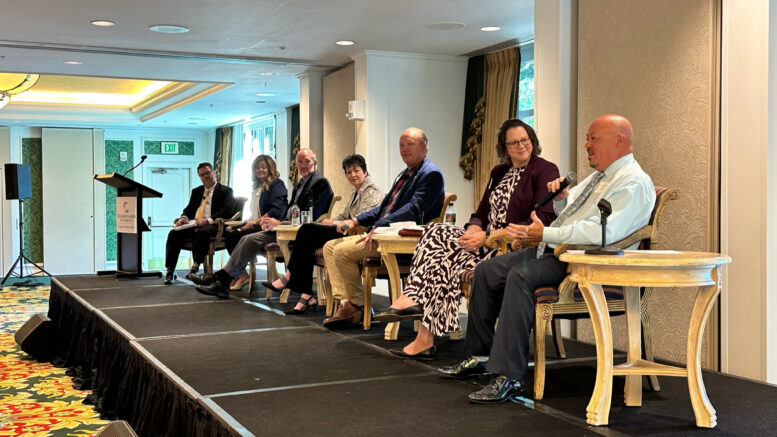Discussions about the next major affordable-housing proposal are heating up around the Colorado Capitol, and ideas about everything from overhauls of local control to construction-defects reform to the return of a rent-control bill are being bandied about.
Leaders of local chambers of commerce say, however, that Colorado leaders could achieve measurable results even with other, less controversy-generating proposals. And those potential solutions, said a sextet of directors, should focus on a reduction in homebuilding regulations and a boost in efforts to grow the overall stock of housing and to improve workforce development such that more people could afford housing.
The ideas, offered at the Future Forum event sponsored by the Colorado Chamber of Commerce late this summer, stand as a sort of starting point that area leaders who hear directly about the workforce woes of local employers want to begin the next round of discussions. The chamber included housing as one of four key priority last week in its Vision 2033 document, a 10-year plan to improve Colorado’s business climate.
And they rest on the belief that housing is not a stand-alone issue, but one that is intractably intertwined with subjects such as workforce shortages and sustainability measures that are expected to be centers of debate when the 2024 legislative session kicks off in January.
“You cannot just go to developers and tell them to make it cheaper,” said Candace Carnahan, president/CEO of the Grand Junction Chamber of Commerce. “It has to be all the stakeholders at the table getting to the point where it’s not so unaffordable.”
Expected housing proposals

Gov. Jared Polis rolls out his affordable-housing bills at a news conference at the Capitol on March 22.
Discussions are likely to begin where they left off on the last day of the 2023 session — at the skeleton of Senate Bill 213, a bill masterminded by Gov. Jared Polis to boost construction by removing barriers to housing proliferation, including some local zoning and permitting authority. That bill died in the Senate after massive local-government pushback, but Polis has said in several speeches this off-season that he again will seek to make multifamily construction more of a use by right along transit-oriented and key corridors to increase high-density housing there.
A coalition of construction, homebuilding and economic-development groups, meanwhile, plans to push legislation that would reform the state’s construction-defects laws in an effort to reduce litigation that members believe is forestalling building of more affordable condominiums. And backers of a 2023 bill allowing local governments to implement rent-control measures are likely to bring back that measure after it failed by one vote in a Senate committee.
But Carnahan believes one of the first things the Democratic governor and Democrat-dominated Legislature should do is examine laws that already are in place and ask if they are hindering affordable-housing construction. She pointed to bills such as greener building-code standards that passed in 2022 and noted that, however much they may help the state to achieve its environmental goals, they also drive up the cost of construction, making it near impossible for developers to offer lower prices when their costs rise substantially.
Ideas from local leaders
“What is it that we should be providing, versus what do we need to provide?” she said, espousing that the state must ensure quality housing construction but doesn’t need to require the “bells and whistles” that laws requiring energy-saving devices mandate.
Chris Romer, president/CEO of the Vail Valley Partnership, agreed that incentivization of needed products, such as affordable housing, is a viable role of the government, but he said the state needs to look beyond traditional tax breaks when it thinks about incentives. Specifically, he believes state and local governments should work in partnership to fast-track permit applications for below-market-price housing, speeding up the design and review processes for those builders and pushing such applications to the front of the line.

Ed Sealover, Colorado Chamber of Commerce vice president of strategic initiatives, moderates the Future Forum event in August.
“If you don’t have your project reviewed within 60 to 90 days, we’ve suggested to our county, then you’re approved,” Romer told the Future Forum crowd gathered at The Broadmoor in Colorado Springs on Aug. 31.
Duane Nava, president/CEO of the Greater Pueblo Chamber of Commerce, said he would like to partner with government leaders to push for construction of more housing at any price point, as that new construction would lead to existing homes selling at more affordable prices. In his area, the total lack of available housing on the market has been a deterrant to attracting new and younger workers who see few viable options on where they can live.
Workforce development and housing
The link between affordable housing and workforce was one that several local chamber leaders described as very direct. Lola Woloch, president/CEO of the Southern Colorado Women’s Chamber of Commerce, went further and tied both issues into the increasing cost of business regulations by saying the key to helping workers afford housing is to allow employers to pay them good salaries by not requiring diversion of resources to regulatory compliance.
Romer argued that as the state looks to boost the supply of affordable housing, it also needs to boost the state’s in-house workforce-development pipeline, which will give more local graduates the ability to attain jobs with good salaries and put money toward housing. The lack of workers in some areas such as his are causing demographic issues that impact all businesses’ models, and boosting the amount of homegrown skilled talent rather than just attracting out-of-state workers will create a market that requires more housing construction, he said.
Thinking beyond statutory adjustments
Solutions will involve more than just changes in law, however, the local chamber leaders said. And sometimes the state and local communities will have to examine changes in the perceptions of residents toward housing to lay the groundwork for any legal fixes.
Jack Llewellyn, CEO of the Durango Chamber of Commerce, said local leaders just launched a home-share program in which they are asking people to rent extra rooms in their homes to individuals with whom the program can match them. They are pitching this as a dual benefit in which empty nesters or members of small households can earn extra income while allowing teachers and other public servants a better chance to be able to afford to live in the community.
Ann Hutchinson, president/CEO of the Fort Collins Area Chamber of Commerce, said business and government leaders need to work together on efforts to point out how detrimental a no-growth mindset among residents can be — even before they look to change laws. Officials in her city last year passed zoning-code reform that was meant to encourage greater housing density and help to alleviate rising housing costs, but a group of residents quickly collected enough signatures against the plan to force the City Council to repeal it.
